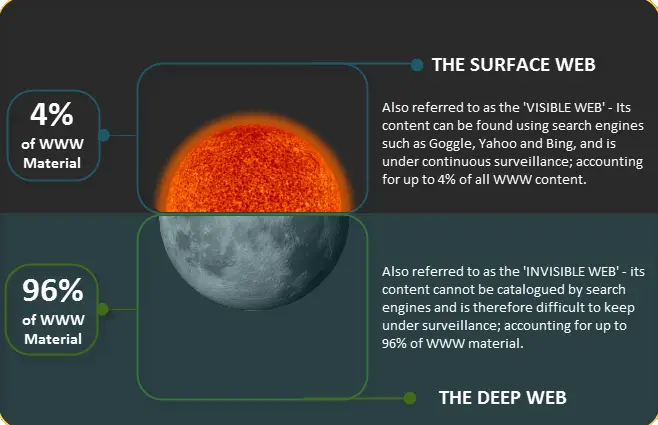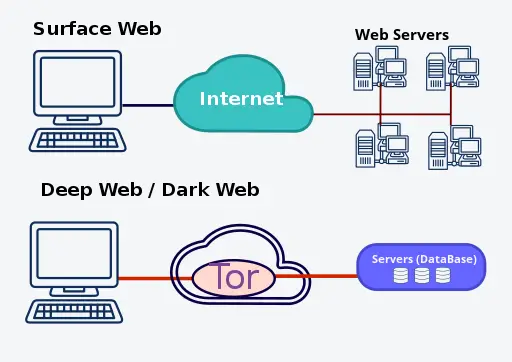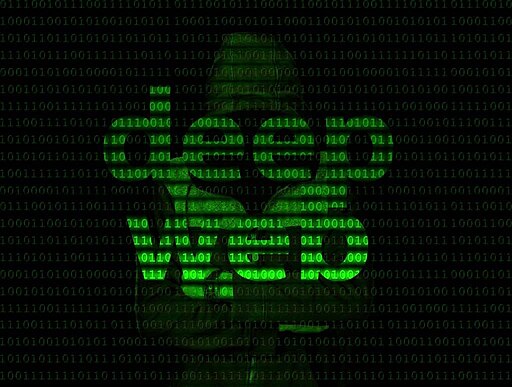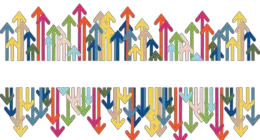The deep web includes web pages not indexed by search engines, while the dark web is a subset with intentionally hidden, often illegal content.
TL;DR Deep web Vs. Dark web
The deep web encompasses all those websites and content that are not indexed by search engines and require specific access permissions. It includes pages behind paywalls, private databases, government archives, academic research repositories, and more. The deep web represents a vast majority of internet content that is not accessible through traditional search methods but can be perfectly legal and harmless.
The dark web refers to a small portion of the deep web that intentionally hides its identity using encryption technology like Tor. The dark web has gained infamy due to its association with illegal activities such as drug trafficking, cybercrime forums, hacking services for hire, and even illicit marketplaces selling weapons or stolen data.
What is the deep web?

The deep web, often referred to as the “invisible web,” is a vast and expansive part of the internet that cannot be accessed through traditional search engines like Google or Bing. It comprises all the content online that is not indexed or easily accessible to the general public. Think of it as an iceberg, with only a small portion visible above the surface.
So what exactly can you find in this hidden digital realm? Well, everything from private databases and academic resources to subscription-based websites and confidential government documents resides here. These are pages that require specific authentication or credentials to access.
One common misconception about the deep web is that it’s inherently illegal or shady. However, this isn’t entirely accurate. While there may be illicit activities taking place within its depths, such as black market transactions or hacker forums, there are also legitimate reasons for content residing in this obscure corner of cyberspace.
For instance, medical records stored on hospital servers, corporate intranets housing sensitive information, and even your personal email account behind a login screen – these are all part of the deep web too.
What is the dark web?

Unlike the deep web, which consists of websites not indexed by search engines, the dark web refers specifically to encrypted networks and websites that require special software to access.
Within this clandestine network lies a hub for illegal activities such as drug trafficking, hacking services, counterfeit goods, stolen data sales, and even human trafficking. The anonymity provided by cryptocurrencies like Bitcoin further fuels these illicit transactions on the dark web.
It’s important to note that while some individuals may use it for legitimate purposes such as anonymous communication or bypassing censorship in oppressive regimes, its association with criminal activities has given it a notorious reputation.
Exploring or venturing into the dark web without proper precautions can be dangerous and potentially illegal. Law enforcement agencies are actively monitoring these platforms to curb criminal behavior online.
Deep web Vs. Dark web – Key differences
| Accessibility | Accessible but not indexed | Requires special software |
|---|---|---|
| Content | Legal and non-indexed | Contains illegal content |
| Searchability | Not searchable by search engines | Not searchable by regular browsers |
| Size | Much larger in size | Smaller in comparison |
| Purpose | Privacy, security, and accessibility | Anonymity and secrecy |
| Examples | Private databases, email accounts, subscription sites | Hidden marketplaces, illegal forums, etc. |
| Legal Status | Mostly legal | Often associated with illegal activities |
The deep web consists of web pages that aren’t indexed by standard search engines and includes a wide range of legitimate and legal content, such as private databases and subscription sites.
The dark web is a small portion of the deep web and is intentionally hidden and accessed through special software like Tor. It is known for hosting illegal activities and content.
Image Credits
Featured Image By – Gerd Altmann, CC0, via Wikimedia Commons
Image 1 By – T, CC BY-SA 3.0 , via Wikimedia Commons
Image 2 By – Ranjithsiji, CC BY-SA 4.0 <https://creativecommons.org/licenses/by-sa/4.0>, via Wikimedia Commons







